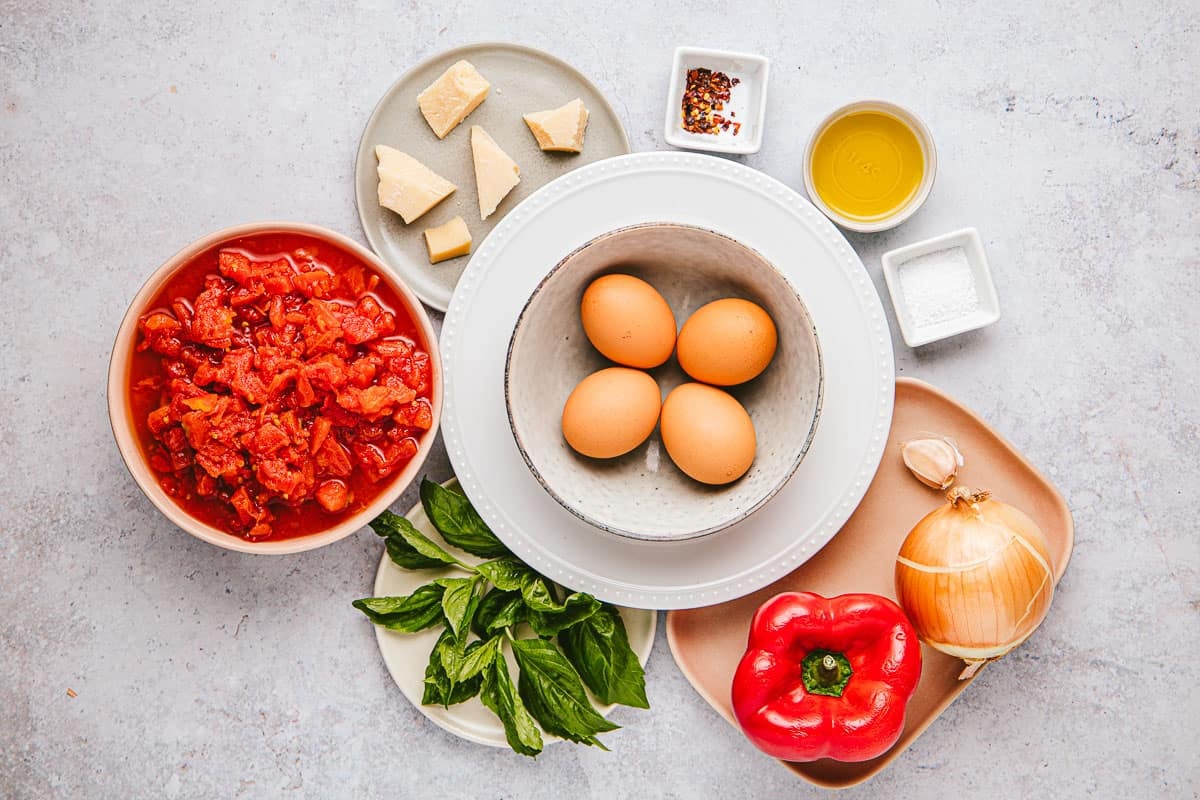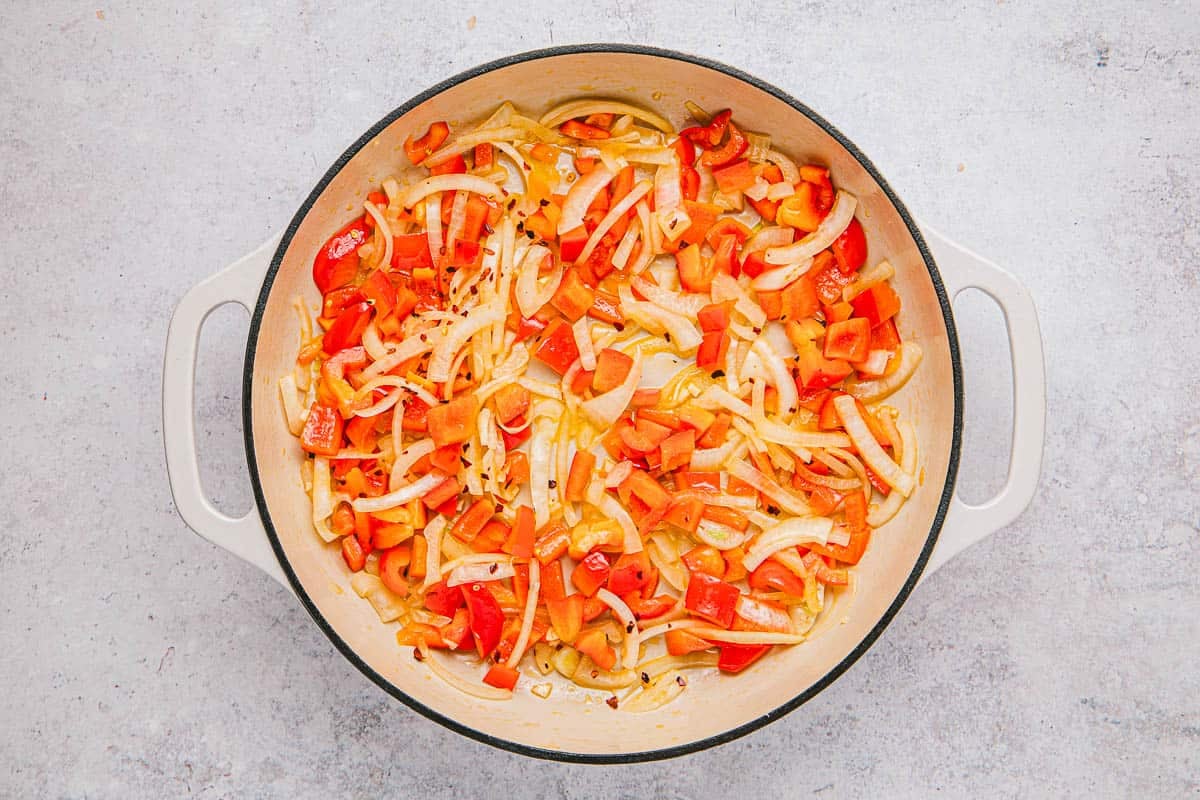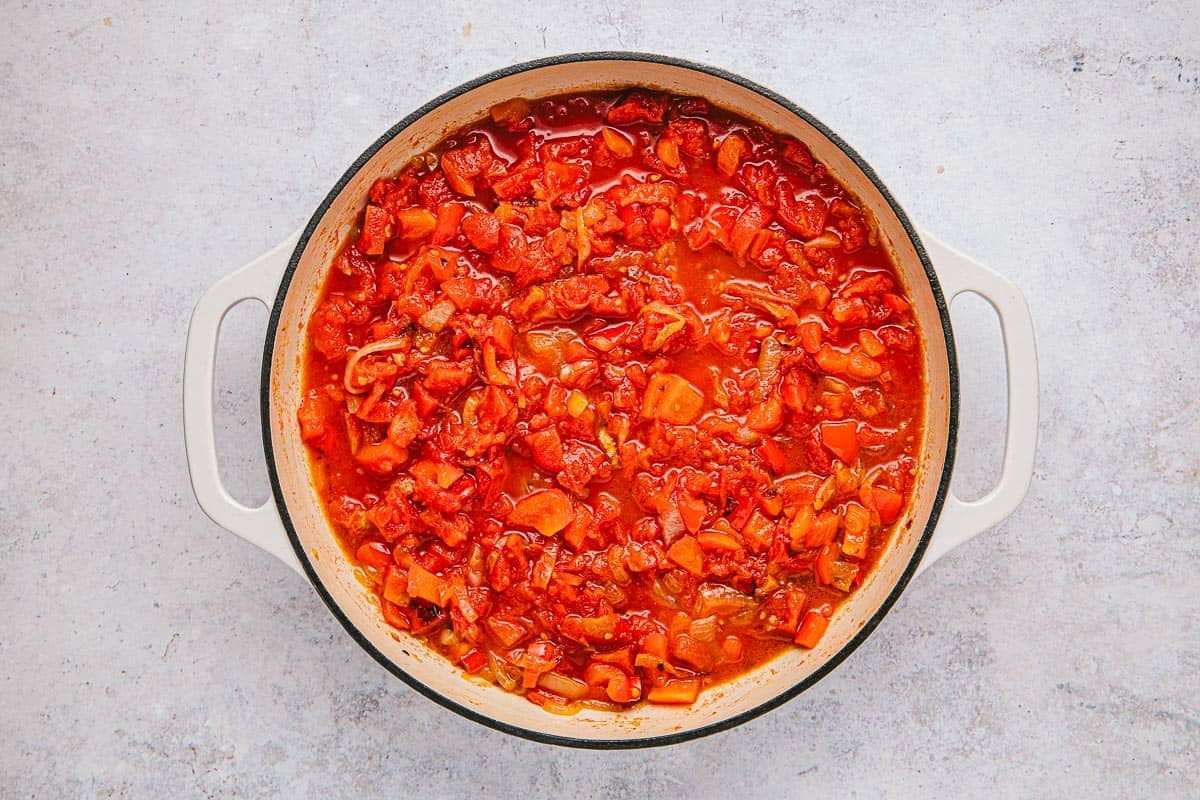Eggs in Purgatory, or Uova al Purgatorio as it’s called in Italy, is a humble Italian breakfast made of eggs gently poached in a spicy tomato sauce. It’s so delicious you’d never guess it’s made from just a few pantry staples!

Eggs in Purgatory is an easy and versatile dish that makes a great centerpiece for brunch or lunch. The tomato sauce, flavored with onion and spiked with red pepper flakes, provides a soft bed for the eggs, which simmer gently until the whites are set and the yolk is still runny.
Serve with crusty bread or homemade focaccia to soak up the flavorful sauce, or enjoy as a quick and delicious weeknight supper with a side of crispy smashed potatoes. This eggs in purgatory recipe is a classic example of “cucina povera,” or the affectionate name given to “poor man’s cuisine.” Home cooks with few luxuries on hand made something amazingly delicious out of nothing. It’s Italian culinary ingenuity at its best!
Table of Contents
- What’s the Difference between Eggs in Purgatory and Shakshuka?
- Why is it Called Eggs in Purgatory?
- Where is Eggs in Purgatory From?
- What’s in Eggs in Purgatory?
- How to Make Eggs in Purgatory
- Swaps and Substitutions
- What to Serve with Eggs in Purgatory
- More Mediterranean Breakfast Ideas
- Eggs in Purgatory (Uova in Purgatorio) Recipe
What’s the Difference between Eggs in Purgatory and Shakshuka?
Eggs in Purgatory is often compared to Shakshuka, a similar brothy soft poached egg and aromatic tomato sauce dish. While similar to Middle Eastern Shakshuka, the way the sauce is seasoned is quite differently. Instead of feta and mint, Italian flavors like fresh basil and Parmigiano-Reggiano take center stage.
Why is it Called Eggs in Purgatory?
Eggs in Purgatory gets its name from the amorphous egg white surrounding the yolks, said to evoke the souls of those in Purgatory. The red, spicy sauce represents the flames by which those doomed souls are surrounded.
It’s a somber take on such a delicious dish! One that brings to mind other creatively titled spicy Italian dishes like “Assassin’s Pasta” and “Angry Penne.”

Where is Eggs in Purgatory From?
Uova al Purgatorio is most associated with Neapolitan cuisine in Southern Italy. Neapolitans are especially famous for turning humble ingredients into fantastic meals. Still, you’ll find similar versions in other parts of southern Italy, including Sicily.
Whereas in Abruzzo, the region my family is from, we add diced sweet pepper to punch up the flavor. So, of course, I’ve included this addition to carry out my family’s delicious traditions. Plus, it adds a nice pop of sweetness.

What’s in Eggs in Purgatory?
One reason Eggs in Purgatory is so popular is because you can make it with just a handful of ingredients. And, most of this list is likely already in your pantry or fridge. It’s one of those dinner-saving dishes that has come to my rescue over and over again. Here are the ingredients you need to make Eggs in Purgatory:
- Extra-virgin olive oil: You need just 3 tablespoons to make Eggs in Purgatory. Use a high-quality oil that tastes fresh, like our Nocellara Italian EVOO.
- Yellow onion and garlic: These two aromatics form the foundational flavor of the poaching sauce. Yellow onions boast more flavor. But, you can also substitute with white onions or shallot if that’s what you have at your disposal.
- Red pepper flakes: Without a generous pinch, it wouldn’t be Eggs in Purgatory. Spice is what makes this dish pop!
- Red bell pepper: Although this is optional, I always add it to my Eggs in Purgatory. The pepper gives the tomato sauce an extra layer of flavor and adds a touch of sweetness.
- Finely chopped canned tomatoes: Canned tomatoes are convenient because there’s no peeling, and they are available year-round. You can also use whole tomatoes. Just make sure you reduce them to a pulp using a potato masher. Or, you can squeeze the tomatoes with your hands (wear an apron!).
- Eggs: Eggs are the shining stars of this recipe. Large eggs will be the most luxurious, but if you have small eggs they will work too. Keep an eye on smaller eggs; you will likely need to reduce the cook time so they simmer to soft-poached.
- Fresh basil: Tossing in a few leaves of fresh basil at the end perfumes the entire dish. Plus, the leaves add a pretty splash of color.
- Parmigiano or Pecorino cheese: Cheese is optional. But, I can’t resist sprinkling a handful of freshly grated parm or pecorino just before serving.
- Salt: Fine salt amplifies the flavors in the whole dish.
- Bread: Bread is also optional but I never skip it! It really is quite satisfying to have a vessel for soaking up all the flavorful tomato broth.
How to Make Eggs in Purgatory
Eggs in Purgatory need a big, luxurious bath to gently poach. A wide skillet is best. The sauce cooks down quickly, and there’s plenty of room for poaching the eggs.
- Make the tomato sauce: Add 3 tablespoons olive oil to a skillet. Add one small thinly sliced onion and a lightly crushed clove of garlic. Next, stir in a large pinch of red pepper flakes and one chopped red bell pepper, if using. Cook on medium-low to soften the onion and pepper, about 10 minutes. If the pepper isn’t quite tender, cover the pan partially and cook 5 minutes longer to soften it further.
- Add the tomatoes: Add 3 cups of chopped tomatoes and season everything with a healthy pinch of salt. Bring the tomatoes to a simmer. Cover partially and cook until the tomatoes have darkened in color and started to thicken about 15 minutes. Uncover and cook for another 5 minutes or so, until the sauce is nicely thickened.
- Poach the eggs: Using the back of a spoon, make four wells in the sauce. Make sure they are wide enough to hold the eggs. When ready, crack an egg into each of the 4 wells and sprinkle tiny pinches of salt on top of each egg. Cover and cook at a gentle simmer over medium-low heat until the whites are set but the yolks are still tender, about 2-3 minutes.
- Garnish and serve: Remove the pan from the heat. After the eggs are cooked, add the final touches. Simply, tear a few fresh basil leaves over the eggs and sauce. Sprinkle freshly grated Parmigiano or Pecorino cheese on top and serve right away.
Swaps and Substitutions
The simplicity of Eggs in Purgatory makes it a great dish to play around with—almost irresistible. Here are some ways you can change up Eggs in Purgatory and make your own signature family recipe:
- Stir in more herbs. Add a pinch of dried oregano or a few sprigs of fresh marjoram to the aromatics. Or sprinkle some chopped fresh parsley on top of your eggs right before serving.
- Add more vegetables. Although this isn’t traditional, in summer try adding sautéd diced eggplant or zucchini with the onion and garlic. You could do this instead of or in addition to the pepper. A handful of baby spinach in the final minutes would also add a fresh and flavorful twist.
- Add mozzarella: Sometimes I arrange thinly sliced mozzarella cheese around the eggs. The cheese melts as the eggs cook, almost like a pizza topping.
- Swap in in ricotta salata. Instead of Parmigiano or Pecorino, try crumbling on a handful of ricotta salata. It’s a salty, pressed version of ricotta that crumbles nicely and adds a tangy flavor.
- Add a dollop of pesto. If fresh basil isn’t available, add a few dollops of jarred or homemade pesto towards the end of cooking.

What to Serve with Eggs in Purgatory
Eggs in Purgatory is such a versatile dish. You can serve it for breakfast, brunch, lunch, or even a quick vegetarian dinner.
For brunch or lunch, serve Eggs in Purgatory with warm, thick slices of crusty Italian bread, such as ciabatta. Easy Antipasto Skewers would make for a nice welcome to the party. Or, for a lighter take, lemony Blanched Asparagus is a colorful and fresh side dish.
For an easy vegetarian dinner, Crispy Smashed Potatoes makes a quick, nutritious, and satisfying supper.
More Mediterranean Breakfast Ideas
Moroccan and Tunisian
White Bean Shakshuka
Breakfast
Green Shakshuka Recipe
Breakfast
Easy Shakshuka Recipe
Breakfast
Eggs Fra Diavolo
Browse all Mediterranean recipes.
Visit Our Shop.
Eggs in Purgatory (Uova in Purgatorio)

Ingredients
- 3 tablespoons extra virgin olive oil
- 1 small yellow onion, thinly sliced
- 1 garlic clove, lightly crushed and peeled
- Generous pinch red pepper flakes
- 1 red bell pepper (optional), coarsely chopped
- Fine salt
- 1 (28 ounce) can chopped tomatoes
- 4 large eggs
- 5-8 fresh basil leaves, torn
- 3-4 tablespoons freshly grated Parmigiano-Reggiano or Pecorino Romano
- Crusty bread (optional), for serving
Instructions
- Make the base: In a large skillet or wide saucepan with a lid set over medium-low heat, stir together the olive oil, onion, garlic, red pepper flakes, and red bell pepper. Cook, stirring, until the onion and peppers are softened, about 10 minutes. If the bell pepper isn’t quite tender, cover the pan partially and cook for another 5 minutes, until the pepper is softened but still holds its shape. Season with a generous pinch of salt.
- Add the tomatoes: Stir in the tomatoes and bring to a simmer over medium heat. Lower the heat to medium-low, cover the skillet partially and simmer gently until the tomatoes have darkened in color and thickened, about 15 minutes. Uncover and cook another 5 minutes until the sauce is nicely thickened.
- Poach the eggs: Use the back of a spoon to carve out 4 wide wells in the sauce, making homes for your eggs. Crack the eggs into the wells and season each with a sprinkle of salt. Cover the pan and cook gently until the whites are set and the yolk is still runny, about 2-3 minutes.
- Serve: Remove from the heat and garnish with torn fresh basil leaves and cheese. Serve right away, with good bread on the side.
Video
Notes
Nutrition
Bundle and Save!
Four of our best-selling signature olive oils, perfect for everyday use.











Make this for dinner tonight and it was so good. I added a couple more eggs and doubled the cheese. I also made your 5 ingredient flat bread to dip it in and that was imazing.
Perfect combo! Yum!
Planning to serve this for brunch. Any tips on what can be prepared ahead of time?
Hi, Jenn. I think you could totally make the sauce ahead of time (steps 1 and 2), then reheat that and poach the eggs in it right before serving.
A childhood favorite. Great comfort food.
Serve for brunch with a nice crisp perseco.
Caramelize onions with a pinch of sugar and that will balance the red pepper flakes.
Offer a pinch of chilli powder to those who like the heat…they can add to their plate.
Thanks so much, Mia!
Made this today and it turned out fantastic! Skipped the red pepper flakes because I can’t do spice and would def recommend the red pepper. Very flavorful!
Thanks so much for the great review, Lindsay! If red pepper flakes are too much heat for you, but you still want a little kick, I highly recommend trying Aleppo Pepper.
The eggs took much longer to set than 2-3 minutes but this is a warm and tasty meal.
Where in Abruzzo is your family from. Ours still live in Roca Monte Piano.. Our cousin is the priest at St. Roccos
My Nonna was from Naples. Nothing was wasted so they used leftover sauce and day old bread loves. It was a struggle meal for them but a special meal for me.